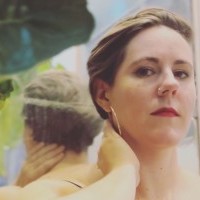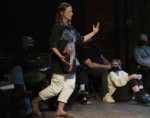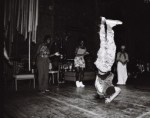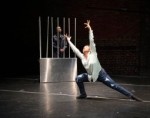
Singing and Dancing through a 24-Hour Mandatory Waiting Period
By Ella-Gabriel Mason
You sit in a darkened theater, staring down at the red velvet curtains. A high-pitched cooing. “Hello, Mommy!” The crimson folds part slightly revealing an alien. . . or rather an actress clad in a garish fetus costume. A skin-tone bodysuit covered in winding veins, complete with a mushroom shaped headpiece, a long proto-spine, and a swinging umbilical chord. Balancing on her tailbone on a chair she seems to float, hands and legs gently aloft in imagined amniotic fluid. The curtains open further revealing a full cast of fetuses cooing, saying hello, describing their current size (“I’m the size of a binder clip. . . a mastercard. . . a cherry.”) The fetal performers are lit in pools of red, blue and green light casting some as children-to-be and others as formaldehyde specimens. A Fosse-esque horror clown show.
The Appointment, an original musical by Philadelphia-based theater group Lighting Rod Special, is about abortion. I hadn’t realized that I entered the theater with assumptions about what an abortion debate musical might be. By the end of the first number, a high energy song and dance by the full 7 member fetus cast, I realized that I both had assumptions and that it was time to let them go.
Rather than explore the abortion debate through pro-life and pro-choice characters, The Appointment alternates between scenes of matter-of-fact presentations of an abortion clinic appointment, with the actors portraying female patients and male health care providers, and comic bits of clowning by the same performers in their fetal garb.
When the fetuses are on stage the energy is explosive. The fetuses are aware of the audience, staring at us and fidgeting in a clump of shy energy. They describe bits of phrases they enjoy hearing from the world outside the womb. They play with their umbilical cords, using them as microphones, as twirling tassels, as a comfort object like the cowardly lion’s tail.
In an extended bit of audience interaction 3 female performers in their fetal garb go on a search for their ideal Daddy. They pick out men in the audience and ask them for help naming themselves (“After the first female member of the Supreme Court. . . you know her name, right?”), they ask for snacks (“I need nutrients. . . I need a Snack Daddy”), and most uncomfortably they ask their chosen audience daddy if they are hot. Throughout they walk a tightrope between sultry and toddler-like in voice and posture, showing how closely scripts of female flirtation are associated with childishness. It’s hilarious and painful.
The abortion clinic scenes, by contrast, are quiet and realistic. The actors wear street clothes, hospital gowns, and scrubs. They answer questions directly and don’t display any awareness of the audience. The energy is contained, the thrum of an engine stalled. Much of what happens is waiting and I felt the discomfort of that waiting in my bones. Twice we watch a patient taken through rituals of care - blood pressure cuff, pulse, temperature check. The first time before she is asked to see a sonogram of the fetus and subjected to legally required misinformation. The second time when she comes back for the procedure after her 24 hour waiting period. The abortion itself is portrayed primarily with stillness. We see the sonogram technician and the doctor in their places. We see the patient breathing, tension most eloquently displayed by the small twitches of her long toes, curled around the exam table stirrups. And then it's over. For all the drama and pageantry of the fetuses' numbers the procedure itself is rendered simple, boring, and ambiguous as to its level of violence or loss.
The commitment by the actors in each mode is phenomenal. They fully inhabit each muscle and fiber of their characters, from a well-intentioned doctor to a mega-church pro-life preacher to a sexy baby fetus.
On balance, the clowning scenes were more plentiful and extended than was strictly necessary and I found myself wanting to get back to the “real” people. And was that the point? To tire of the stories of the unborn? I’m not entirely sure. But for me The Appointment hit my gut when it focused on the small and simple gestures. The shuffling of cash by the patients in the waiting room which transitions into a powerful song by the 4 female performers, resisting the ways their choices are framed not only by laws but by narratives as well. As they sing they rip apart the waiting room magazines, their fury and frustration given the smallest outlet.
By Ella-Gabriel Mason
February 19, 2023









